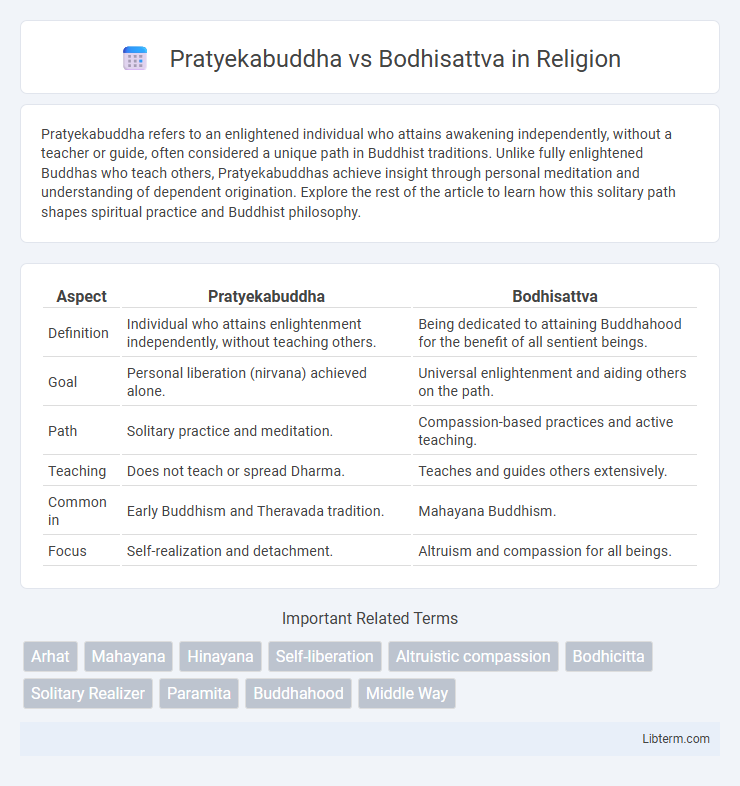Pratyekabuddha refers to an enlightened individual who attains awakening independently, without a teacher or guide, often considered a unique path in Buddhist traditions. Unlike fully enlightened Buddhas who teach others, Pratyekabuddhas achieve insight through personal meditation and understanding of dependent origination. Explore the rest of the article to learn how this solitary path shapes spiritual practice and Buddhist philosophy.
Table of Comparison
| Aspect | Pratyekabuddha | Bodhisattva |
|---|---|---|
| Definition | Individual who attains enlightenment independently, without teaching others. | Being dedicated to attaining Buddhahood for the benefit of all sentient beings. |
| Goal | Personal liberation (nirvana) achieved alone. | Universal enlightenment and aiding others on the path. |
| Path | Solitary practice and meditation. | Compassion-based practices and active teaching. |
| Teaching | Does not teach or spread Dharma. | Teaches and guides others extensively. |
| Common in | Early Buddhism and Theravada tradition. | Mahayana Buddhism. |
| Focus | Self-realization and detachment. | Altruism and compassion for all beings. |
Understanding Pratyekabuddha: Definition and Characteristics
Pratyekabuddhas are solitary enlightened beings who achieve awakening independently, without a teacher, and do not actively teach others, distinguishing them from Bodhisattvas who seek enlightenment to aid all sentient beings. They practice intense meditation and insight into dependent origination but remain detached from the cycle of teaching, emphasizing personal liberation. Pratyekabuddhas represent a unique path in Buddhism focused on individual realization rather than collective salvation.
Who Is a Bodhisattva? Key Attributes Explained
A Bodhisattva is an enlightened being in Mahayana Buddhism who postpones final nirvana to help all sentient beings achieve liberation. Key attributes include compassion (karuna), the aspiration for universal enlightenment (bodhicitta), and the practice of the Six Perfections (paramitas) such as generosity, morality, patience, effort, concentration, and wisdom. Unlike a Pratyekabuddha who attains enlightenment independently without teaching others, a Bodhisattva actively engages in guiding and saving others on the path to awakening.
Historical Origins of the Pratyekabuddha and Bodhisattva Ideals
The Pratyekabuddha ideal originated in early Indian Buddhism as solitary enlightened beings who attain nirvana independently, without teaching others, reflecting a path emphasized in the early Buddhist texts like the Pali Canon. In contrast, the Bodhisattva ideal emerged from Mahayana Buddhism, championing compassionate beings who postpone their own final enlightenment to assist all sentient beings, rooted in scriptures such as the Lotus Sutra and the Avatamsaka Sutra. These historical distinctions highlight the Pratyekabuddha's solitary path versus the Bodhisattva's altruistic mission within Buddhist spiritual traditions.
Core Philosophical Differences: Pratyekabuddha vs Bodhisattva
Pratyekabuddhas attain enlightenment independently without guiding others, emphasizing personal liberation and solitude, whereas Bodhisattvas deliberately delay their own nirvana to assist all sentient beings toward liberation. The core philosophical difference lies in their spiritual motivation: Pratyekabuddhas prioritize self-enlightenment through insight into phenomena, while Bodhisattvas embody compassion and altruism, committing to the collective awakening through the Six Perfections (paramitas). This contrast reflects divergent ideals within Mahayana Buddhism, with Bodhisattvas representing ideal altruistic enlightenment and Pratyekabuddhas embodying solitary wisdom.
The Role of Compassion: Contrasting Motivations
Pratyekabuddhas pursue enlightenment independently, motivated primarily by personal liberation rather than altruistic concern, often embodying a solitary path with limited emphasis on compassion for others. In contrast, Bodhisattvas embody profound compassion, deliberately postponing their own full enlightenment to assist all sentient beings in overcoming suffering. This fundamental difference highlights the Bodhisattva's altruistic commitment versus the Pratyekabuddha's introspective focus on self-awakening within Mahayana and Theravada traditions.
Attainment of Enlightenment: Individual vs Collective Paths
Pratyekabuddhas attain enlightenment independently without relying on teachers or guides, often in solitude, emphasizing personal insight and self-liberation. Bodhisattvas pursue enlightenment through compassion and dedicate themselves to aiding all sentient beings, embodying a collective path that integrates personal awakening with altruistic service. This contrast highlights the Pratyekabuddha's solitary realization versus the Bodhisattva's communal commitment to universal salvation.
Scriptural References for Pratyekabuddha and Bodhisattva
Pratyekabuddhas are described in scriptures such as the Pali Canon and the Mahayana sutras, characterized by their solitary enlightenment without teaching others, as seen in texts like the Anguttara Nikaya and the Abhidharma literature. Bodhisattvas are extensively depicted in Mahayana sutras such as the Lotus Sutra, Avatamsaka Sutra, and the Jataka tales, emphasizing their compassionate vow to attain Buddhahood for the sake of all sentient beings. Scriptural references contrast Pratyekabuddhas' solitary path with Bodhisattvas' altruistic commitment, highlighting different spiritual ideals within Buddhist traditions.
Pratyekabuddha in Theravada and Mahayana Traditions
Pratyekabuddhas, recognized in both Theravada and Mahayana traditions, achieve enlightenment independently without teaching others, contrasting with Bodhisattvas who actively guide beings toward liberation. In Theravada Buddhism, Pratyekabuddhas represent solitary enlightened beings who arise in periods when the Dharma is not taught, emphasizing personal realization and meditation practice. Mahayana tradition, while acknowledging Pratyekabuddhas, prioritizes Bodhisattvas for their compassionate commitment to liberating all sentient beings, viewing Pratyekabuddhas as having a limited scope of spiritual influence.
Bodhisattva Vow: Commitment to Helping Others
The Bodhisattva Vow is a profound commitment to alleviating suffering and guiding all sentient beings toward enlightenment, emphasizing compassion and selflessness. Unlike the Pratyekabuddha, who achieves enlightenment independently and remains detached, the Bodhisattva vows to delay their own Nirvana until every being is liberated. This vow represents the essence of Mahayana Buddhism, prioritizing altruistic dedication over solitary liberation.
Contemporary Relevance: Lessons from Both Paths
Pratyekabuddhas emphasize individual enlightenment through self-realization, inspiring modern mindfulness and personal growth practices that prioritize inner peace and autonomy. Bodhisattvas embody compassion and altruistic service, influencing contemporary social activism and community-focused initiatives aimed at reducing suffering. Both paths offer valuable lessons: Pratyekabuddha encourages deep self-awareness, while Bodhisattva promotes collective responsibility and empathy in today's interconnected world.
Pratyekabuddha Infographic

 libterm.com
libterm.com